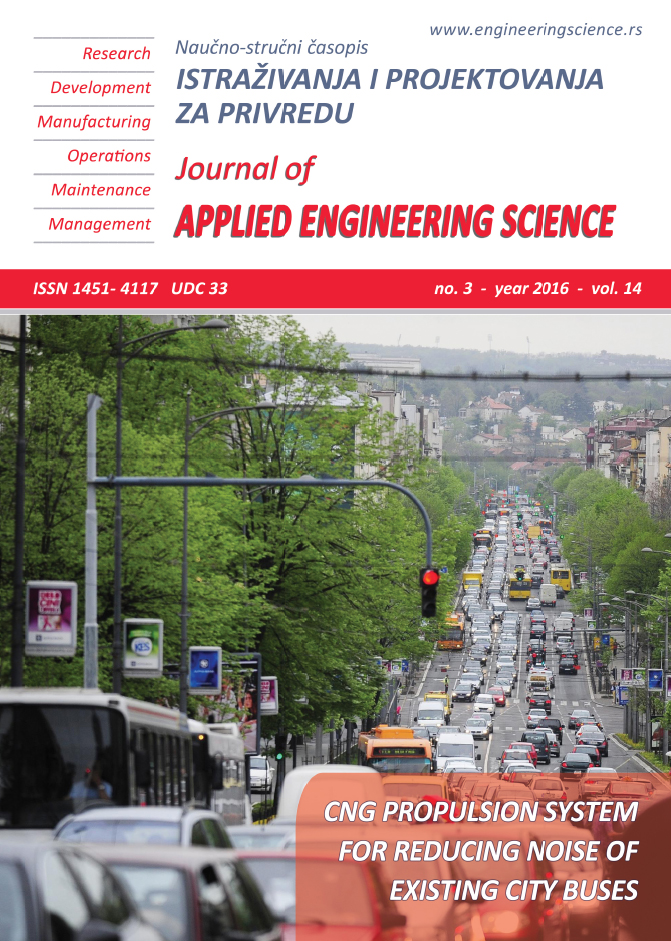THE STUDY OF BIOMASS HUMIDITY IMPACT ON THE EFFICIENCY OF A POWER GENERATING SYSTEM WITHA GASIFIER AND THE STIRLING ENGINE
Abstract
The aim of this study is to determine the impact of fuel wood chips humidity on the overall efficiency of the power module mobile chipper consisting of a gasifier, the Stirling engine and a container-dryer, as well, as to research utilization efficiency of heat emissionsof the Stirlingengine in a container-dryer of self-design. A mathematical model of the autonomous power module mobile chipper with fuel chips functioning was created. In addition, the physical experiment was conducted to determine the actual moisture content of wood chips after drying due to thermal emissions of the Stirling engine. According to the results of the experiments we obtained regression equations of the efficiency of the power-generating unitdependence on the initial moisture content of biofuels for two cases - with drying in the container-dryer and without drying. Drying of fire wood chips due to utilization of thermal emissions of the Stirling engine in a container-drier of a proposed design improves the efficiency of the power-generating unit. The reduction of the fuel wood relative humidity from 47.5% to 37.5% increases the efficiency by 7.34%,while moisture reduction from 37.5% to 27.5% results in higher efficiency of only 4.37%, a further reduction in moisture from 27.5% to 17.5% results in higher efficiency of only 2.47%. Thus, the greatest positive effect of drying fire wood chips due to heat recovery of the Stirling engine emissions is observed when using fuel wood with high initial moisture content of more than 30%.
References
/1/ Anisimov, P.N., Onuchin, E.M. (2015) Performance assessment and ways of energy efficiency increase of chip fuel production, Energy production: efficiency, reliability, safety. Proceedings of XXI All-Russian scientific and technical conference in 2 volumes, 1, 252-255.
/2/ Anisimov, P.N., Onuchin, E.M. (2013) Modelling of the energy supply system of mobile technological lines for the production of dry fuel wood chips with the partial usage of the producible biogenic fuel. Polythematic online scientific journal of Kuban State Agrarian University, 89, 518-530.
/3/ Anisimov, P.N., Onuchin, E.M., Arhipova, A.S. (2016) Development of schematics and design solutions of biofuel engine for mobile woodchipper, Al'ternativnyeistochnikijenergii v transportno-tehnologicheskomkomplekse: problemy i perspektivyracional'nogoispol'zovanija, 1 (4), 12-16.
/4/ Boubaker, K., Colantoni, A., Longo, L. (2013) Optimizing the Energy Conversion Process: An Application to a Biomass Gasifier-Stirling Engine Coupling System, Applied Mathematical Sciences, 7 (139), 6931-6944.
/5/ Brammer, J.G. Bridgwater, A.V. (2002) The Influense of feedstock drying on the performance and economics of a biomass gasifier-engine CHP system, Biomass and Bioenergy, 22, 271-281.
/6/ Carlsen, H., Marinitsch, G., Schöch, M., Obernberger, I. (2005) Development of a hot heat exchanger and a cleaning system for a 35 kW hermetic four cylinder Stirling engine for solid biomass fuels, Proceedings of the 12th International Stirling Engine Conference andTechnology Exhibition, 1, 144-155.
/7/ Coskun, C. Bayraktar, Z., Oktay, M., Dincer, I. (2009) Energy and exergy analyses of an industrial wood chip drying process, International Journal of Low-Carbon Technologies, 4, 224-229.
/8/ Erber, G., Routa, J., Kolström, M., Kanzian, C., Sikanen, L., Stampfer K. (2014) Comparing Two Different Approaches in Modeling Small Diameter Energy Wood Drying in Logwood Piles, Croatian Journal of Forest Engineering, 35 (1), 15-22.
/9/ Fagernäs, L., Brammer, J., Wilen, C., Lauer, M., Verhoeff, F. (2010) Drying of biomass for second generation synfuel production, Biomass and Bioenergy, 34, 1267-1277.
/10/ Kotowicz J., Sobolewski A., Iluk T. (2013) Energetic analysis of a system integrated with biomass gasification, Energy, 52, 265-278.
/11/ Rajvanshi, A. (1986): Biomass gasification, Alternative Energy in Agriculture , 2, 83-102.
/12/ Ravich M. B. (1966) The simplified methodology of thermotechnical calculations, Moscow: Science.
/13/ Rokni M. (2015) Thermodynamic analyses of municipal solid waste gasification plant integrated with solid oxide fuel cell and Stirlinghybride system, International journal of hydrogen energy, 40 (24), 7855-7869.
/14/ Sato K, Ohiwa N. (2006) Research and development of Stirling engine power generating system using biomass. Proceedings of the tenth symposium on Stirling cycle, Yokohama, Japan: Kanagawa University.
/15/ Tokarev G.G. (1955) Gas producer vehicles, Moscow: Engineering.
/16/ Truhov, B.S., Tursunbaev, I.A., Umarov, S.Ja. (1979) Calculation of an heat-transfer loop parameters of the Stirling engine, Tashkent: Fan.
/17/ Vedernikova, M.I., Orlov, V.P., Terent'ev, V.B. (2001) Design of drying system for drying of the disintegrating wood, Part 1. Technological and hydrodynamic calculations of dryers, Yekaterinburg: UGLTA.
/18/ Zainal, Z.A. Ali, R., Lean, C.H., Seetharamu, K.N. (2001) Prediction of performance of a downdraft gasifier using equilibrium modeling for different biomass materials, Energy convertion and management, 42, 1499-1515.

